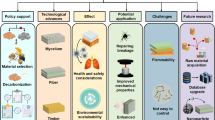Abstract
Architects welcome double skin facade (DSF) due to its aesthetic quality. The first DSF structure was intended to prevent cold weather and strong winds. Nowadays, the application of DSF under different climates has been investigated in many previous studies. However, little work had been done on the behaviour of DSF in hot and humid climates. Therefore, this paper aimed to extend the application into this specific climate and Guangzhou was selected as the sample city. Both the climate and the design influence the performance of DSF. In this paper, rather than explore how each design parameter influences the performance, the design was evaluated from an overall aspect. The Designbuilder software was used to build the single skin facade (SSF) and double skin facade base model. Annual HVAC energy consumption for both the two models was calculated and compared. An optimisation process was conducted to figure out what kinds of parameter combination could make the design more energy-saving and thermally comfortable. The results indicated that it was possible to design an energy-saving DSF system applied in hot and humid climates compared with the SSF model. The efficiency of the DSF could be further enhanced with a better parameter combination. The optimised options had some features in common, which could provide some inspirations for the application of DSF in hot and humid climates.
Similar content being viewed by others
References
Alberto A, Ramos NMM, Almeida RMSF (2017). Parametric study of double-skin facades performance in mild climate countries. Journal of Building Engineering, 12: 87–98.
Azarbayjani M (2010). Beyond arrows: Energy performance of a new, naturally ventilated, double-skin facade configuration for a high-rise office building in Chicago. PhD Thesis, University of Illinois at Urbana-Champaign, USA.
Ballestini G, De Carli M, Masiero N, Tombola G (2005). Possibilities and limitations of natural ventilation in restored industrial archaeology buildings with a double-skin façade in Mediterranean climates. Building and Environment, 40: 983–995.
Barbosa S, Ip K (2014). Perspectives of double skin Facades for naturally ventilated buildings: A review. Renewable and Sustainable Energy Reviews, 40: 1019–1029.
Bedon C, Honfi D, MacHalická KV, Eliášová M, Vokáč M, et al. (2019a). Structural characterisation of adaptive facades in Europe—Part I: Insight on classification rules, performance metrics and design methods. Journal of Building Engineering, 25: 100721.
Bedon C, Honfi D, MacHalická KV, Eliášová M, Vokáč M, et al. (2019b). Structural characterisation of adaptive facades in Europe—Part II: Validity of conventional experimental testing methods and key issues. Journal of Building Engineering, 25: 100797.
Elarga H, de Carli M, Zarrella A (2015). A simplified mathematical model for transient simulation of thermal performance and energy assessment for active facades. Energy and Buildings, 104: 97–107.
Ghaffarianhoseini A, Ghaffarianhoseini A, Berardi U, Tookey J, Li DHW, et al. (2016). Exploring the advantages and challenges of double-skin Facades (DSFs). Renewable and Sustainable Energy Reviews, 60: 1052–1065.
Guardo A, Coussirat M, Egusquiza E, Alavedra P, Castilla R (2009). A CFD approach to evaluate the influence of construction and operation parameters on the performance of Active Transparent Facades in Mediterranean climates. Energy and Buildings, 41: 534–542.
Haase M, da Silva FM, Amato A (2009). Simulation of ventilated facades in hot and humid climates. Energy and Buildings, 41: 361–373.
Halawa E, Ghaffarianhoseini A, Ghaffarianhoseini A, Trombley J, Hassan N, et al. (2018). A review on energy conscious designs of building Facades in hot and humid climates: Lessons for (and from) Kuala Lumpur and Darwin. Renewable and Sustainable Energy Reviews, 82: 2147–2161.
Hamza N (2008). Double versus single skin facades in hot arid areas. Energy and Buildings, 40: 240–248.
Jiru TE, Tao YX, Haghighat F (2011). Airflow and heat transfer in double skin facades. Energy and Buildings, 43: 2760–2766.
Joe J, Choi W, Kwak Y, Huh JH (2014). Optimal design of a multi-story double skin facade. Energy and Buildings, 76: 143–150.
Kim YM, Kim SY, Shin SW, Sohn JY (2009). Contribution of natural ventilation in a double skin envelope to heating load reduction in winter. Building and Environment, 44: 2236–2244.
Lucchino EC, Goia F, Lobaccaro G, Chaudhary G (2019). Modelling of double skin facades in whole-building energy simulation tools: A review of current practices and possibilities for future developments. Building Simulation, 12: 3–27.
Parra J, Guardo A, Egusquiza E, Alavedra P (2015). Thermal performance of ventilated double skin Facades with Venetian blinds. Energies, 8: 4882–4898.
Pérez-Grande I, Meseguer J, Alonso G (2005). Influence of glass properties on the performance of double-glazed facades. Applied Thermal Engineering, 25: 3163–3175.
Qahtan AM (2019). Thermal performance of a double-skin facade exposed to direct solar radiation in the tropical climate of Malaysia: A case study. Case Studies in Thermal Engineering, 14: 100419.
Radhi H, Sharples S, Fikiry F (2013). Will multi-facade systems reduce cooling energy in fully glazed buildings? A scoping study of UAE buildings. Energy and Buildings, 56: 179–188.
Safer N, Woloszyn M, Roux JJ (2005). Three-dimensional simulation with a CFD tool of the airflow phenomena in single floor double-skin facade equipped with a venetian blind. Solar Energy, 79: 193–203.
Shameri MA, Alghoul MA, Elayeb O, Zain MFM, Alrubaih MS, et al. (2013). Daylighting characterstics of existing double-skin facade office buildings. Energy and Buildings, 59: 279–286.
Acknowledgements
This study was supported by the Key Research and Development Program of Anhui Province (No. S202004a07020029).
Author information
Authors and Affiliations
Corresponding author
Rights and permissions
About this article
Cite this article
Wang, M., Hou, J., Hu, Z. et al. Optimisation of the double skin facade in hot and humid climates through altering the design parameter combinations. Build. Simul. 14, 511–521 (2021). https://doi.org/10.1007/s12273-020-0682-6
Received:
Revised:
Accepted:
Published:
Issue Date:
DOI: https://doi.org/10.1007/s12273-020-0682-6




